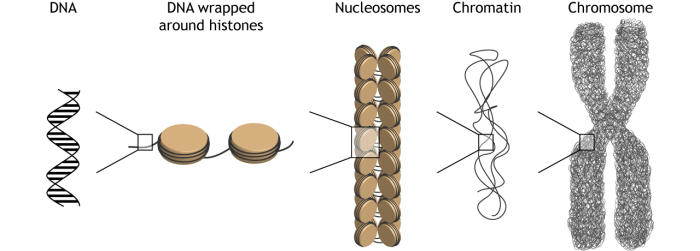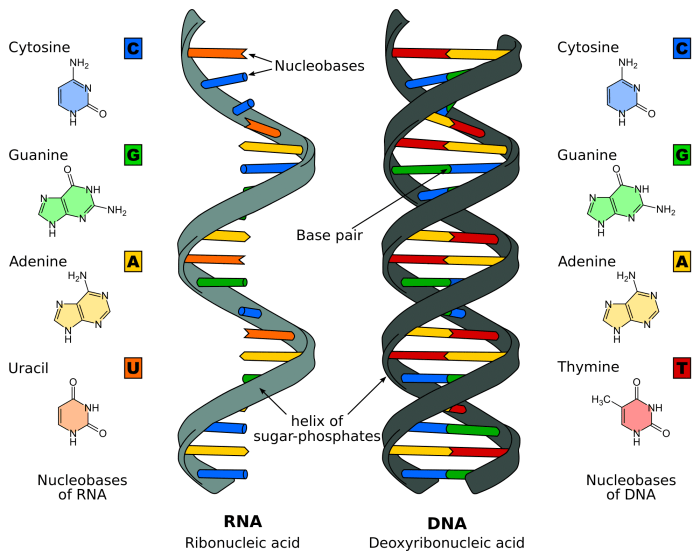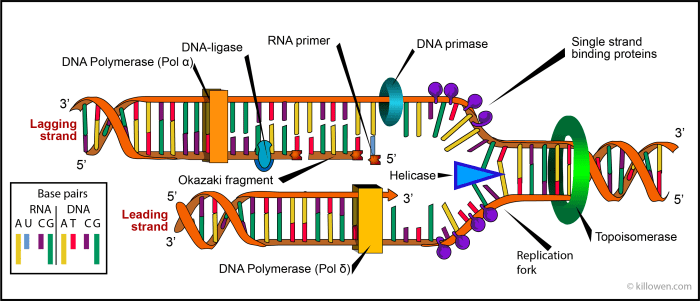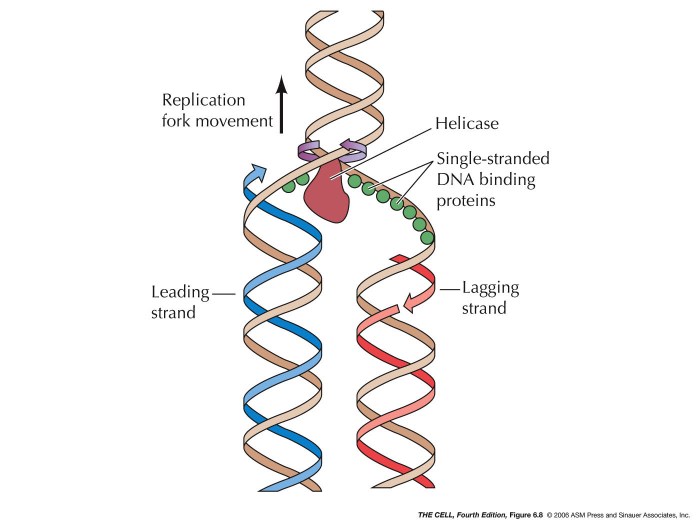Introducing the DNA Structure and Replication Packet, a comprehensive exploration into the fundamental building blocks of life. This packet unravels the intricacies of DNA, delving into its structure, replication process, and far-reaching applications.
From the basic components of nucleotides to the remarkable double helix structure, this guide illuminates the secrets of DNA’s architecture. Witness the intricate dance of complementary base pairing and discover the different types of DNA molecules that shape the genetic landscape.
DNA Structure

DNA, or deoxyribonucleic acid, is a molecule that contains the instructions for an organism’s development and characteristics. It is a long, thin molecule that is made up of four different types of nucleotides: adenine (A), thymine (T), guanine (G), and cytosine (C).
The nucleotides are arranged in a specific order, which determines the genetic code. The genetic code is read by cells to produce proteins, which are the building blocks of life.
Basic Components of DNA
DNA is a polymer, which means it is made up of many smaller units called monomers. The monomers of DNA are nucleotides. Each nucleotide is made up of three parts: a sugar molecule, a phosphate molecule, and a nitrogenous base.
- The sugar molecule is either deoxyribose or ribose.
- The phosphate molecule is a negatively charged molecule.
- The nitrogenous base is one of four types: adenine, thymine, guanine, or cytosine.
Double Helix Structure of DNA
DNA is a double helix, which means it is made up of two strands that are twisted around each other. The two strands are held together by hydrogen bonds between the nitrogenous bases.
The nitrogenous bases are complementary, which means that they always pair up in the same way: adenine always pairs with thymine, and guanine always pairs with cytosine.
Types of DNA Molecules
There are three main types of DNA molecules: A-DNA, B-DNA, and Z-DNA.
- A-DNA is a right-handed double helix with a diameter of 2.3 nm.
- B-DNA is a right-handed double helix with a diameter of 2.0 nm.
- Z-DNA is a left-handed double helix with a diameter of 1.8 nm.
The different types of DNA molecules have different structures and properties. A-DNA is found in dehydrated conditions, while B-DNA is found in hydrated conditions. Z-DNA is found in regions of DNA that are rich in guanine and cytosine.
DNA Replication

DNA replication is the process by which a cell duplicates its DNA before cell division. It occurs in three main steps: initiation, elongation, and termination. Initiationbegins when an enzyme called helicase unwinds the DNA double helix, creating a replication bubble.
Single-strand binding proteins then bind to the separated DNA strands to prevent them from reannealing. Elongationoccurs when an enzyme called DNA polymerase adds nucleotides to the 3′ end of each DNA strand, using the opposite strand as a template. DNA polymerase can only add nucleotides in the 5′ to 3′ direction, so two new DNA strands are synthesized in an antiparallel fashion.
Terminationoccurs when DNA polymerase reaches the end of the template strand. The newly synthesized DNA strands are then annealed to each other by an enzyme called ligase.There are two different models of DNA replication: the conservative model and the semi-conservative model.
The conservative modelproposes that the original DNA double helix is conserved during replication, while two new DNA double helices are synthesized. The semi-conservative modelproposes that each new DNA double helix contains one original strand and one newly synthesized strand. The semi-conservative model is the currently accepted model of DNA replication.DNA
replication is essential for cell division and genetic inheritance. During cell division, each daughter cell must receive a complete copy of the DNA. DNA replication also ensures that genetic information is passed on from one generation to the next.
Enzymes Involved in DNA Replication
* Helicase: Unwinds the DNA double helix.
Single-strand binding proteins
Bind to the separated DNA strands to prevent them from reannealing.
DNA polymerase
Adds nucleotides to the 3′ end of each DNA strand, using the opposite strand as a template.
Ligase
Anneals the newly synthesized DNA strands to each other.
Importance of DNA Replication
* Essential for cell division.
Ensures that genetic information is passed on from one generation to the next.
Applications of DNA Structure and Replication

Our comprehension of DNA structure and replication has revolutionized biotechnology, medicine, and our understanding of evolution. This knowledge has enabled groundbreaking applications in genetic engineering, DNA fingerprinting, the diagnosis and treatment of genetic disorders, and the study of genetic diversity.
Genetic Engineering
Genetic engineering involves manipulating DNA to alter an organism’s genetic makeup. By understanding DNA structure and replication, scientists can insert, delete, or modify specific genes, enabling the creation of genetically modified organisms (GMOs) with desired traits. These GMOs have applications in agriculture, medicine, and industrial biotechnology.
DNA Fingerprinting
DNA fingerprinting utilizes DNA structure and replication to identify individuals uniquely. Each person’s DNA has specific patterns that distinguish them from others, except in the case of identical twins. This technology is used in forensic science, paternity testing, and DNA databases for criminal investigations.
Genetic Disorders and Diseases
Understanding DNA structure and replication is crucial for comprehending the genetic basis of disorders and diseases. By analyzing DNA sequences, scientists can identify mutations and variations associated with specific conditions. This knowledge enables the development of diagnostic tests, targeted therapies, and genetic counseling to prevent or manage genetic diseases.
Evolution and Genetic Diversity
DNA structure and replication are fundamental to understanding evolution and genetic diversity. By studying DNA sequences across species, scientists can trace evolutionary relationships and infer patterns of genetic divergence. This knowledge contributes to our understanding of biodiversity, population genetics, and the origins of life.
DNA Structure and Replication in Different Organisms: Dna Structure And Replication Packet

The structure and replication of DNA exhibit variations across different organisms, reflecting the diversity of life on Earth. Prokaryotes, eukaryotes, and viruses possess distinct characteristics in their DNA organization and replication mechanisms.
Prokaryotes
Prokaryotes, including bacteria and archaea, have a simpler DNA structure compared to eukaryotes. Their DNA is typically organized into a single, circular chromosome located in the cytoplasm. Prokaryotic DNA replication is initiated at a specific origin of replication and proceeds bidirectionally until the entire chromosome is duplicated.
Eukaryotes
Eukaryotes, including plants, animals, and fungi, have more complex DNA structures. Their DNA is organized into multiple linear chromosomes enclosed within a membrane-bound nucleus. Eukaryotic DNA replication is more intricate, involving multiple origins of replication and the formation of replication forks that move in both directions along each chromosome.
Viruses
Viruses are unique entities that possess DNA or RNA as their genetic material. Viral DNA can be single-stranded or double-stranded, linear or circular, and may exist as part of a larger genome or as an independent entity. Viral DNA replication mechanisms vary depending on the virus type, but often involve the use of host cell machinery or specialized viral enzymes.
Examples of DNA Structure and Replication Variations, Dna structure and replication packet
- Bacteria:Circular chromosome, bidirectional replication
- Yeast:Linear chromosomes, multiple origins of replication
- Humans:23 pairs of linear chromosomes, complex replication process
- Bacteriophage lambda:Linear, double-stranded DNA, uses host cell machinery for replication
- HIV:Single-stranded RNA genome, reverse transcriptase enzyme for replication
Q&A
What is the significance of DNA replication?
DNA replication is crucial for cell division and genetic inheritance. It ensures that each new cell receives an identical copy of the genetic material, preserving the genetic integrity of organisms.
How does DNA structure influence genetic disorders?
Alterations in DNA structure can lead to genetic disorders. Mutations, insertions, and deletions can disrupt gene function, resulting in various diseases and conditions.
What is the role of DNA structure and replication in evolution?
DNA structure and replication provide the basis for genetic diversity and evolution. Mutations and recombination events during replication introduce variations that can be passed on to offspring, driving the process of natural selection and the adaptation of species.
